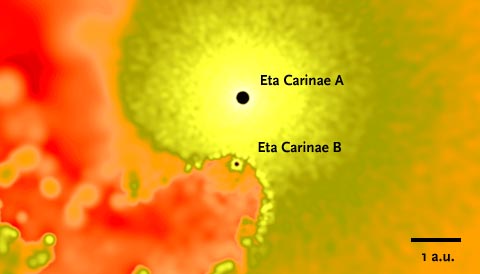
Fade Out (For Now) on SN 1987A
The famous supernova continues to transform: its necklace of hotspots is fading away as the shock wave moves further out.

Aurora on a Dwarf Star
Astronomers have detected what looks like auroral emission on an ultra-cool star.

Astronomers Spot Unusual Five-Star System
Two binary systems and a fifth stellar wheel make for a rare, and so far unique, set of stars.

The Most Luminous Supernova
Astronomers have discovered an exploding star that belongs to the "superluminous" class, and it's the most luminous one ever found.

Pulsar System to Put On a Show in 2018
Astronomers are looking forward to 2018, when a young pulsar will pass through its binary star companion’s disk.

A Budding Nebula May Hatch a Butterfly
Super-sharp imaging confirms that the nearby red giant star L2 Puppis is forming a tiny bipolar nebula as it comes to the end of its life.

Astronomers Observe Rare Stellar Eclipse
Amateur observers helped reveal a rare eclipse of a close stellar pair known as b Persei by a third companion star.

Supernova, Two Ways
Two new studies confirm that the white dwarfs that explode as Type Ia supernovae can approach death in two different ways.

New Ultra-Deep Star Catalog Released
With the initial release of the USNO's Robotic Astrometric Catalog (URAT1), astronomers now have precise positions for about 228 million stars in the northern sky. Given my love of stone walls, I've been thinking about building one in the backyard to enclose the flower beds. But I haven't had the…

Mysterious X-rays Spotted in Galactic Center
NASA’s NuSTAR mission has detected an unexpected haze of high-energy X-rays in our galaxy’s center, perhaps the signal of a mass stellar graveyard.

Do Explosive Bursts Heat the Sun’s Corona?
New evidence suggests that nanoflares, small but potent bursts of energy, might heat the Sun’s atmosphere. But not everybody’s convinced.

Nova Sagittarii: What a Long, Strange Fade It's Been
A 6th-magnitude nova erupted inside the Sagittarius Teapot and reached 4th magnitude. Now it has started fading.

Watching Starbirth in Real Time
A team of astronomers compared two images taken 18 years apart to catch the dramatic evolution of a forming star and its surroundings.

New Stars On Strange Orbits in Milky Way
Astronomers have found two just-born star clusters an incredible 16,000 light-years above the plane of the Milky Way galaxy.

Before They Were (Binary) Stars
Astronomers have taken a behind-the-scenes look at a set of dense gas clumps, catching a quadruple star system in the fleeting act of formation.

Yellowballs: A New View of Star Formation
Thanks to the help of the general public, astronomers have discovered a new signature marking a hidden phase of star formation.

Eta Carinae's Throbbing X-ray Pulse
When the massive, unstable southern star Eta Carinae sent a blast of X-rays into space last July, astronomers around the world were waiting and watching.

New Look at Eagle Nebula
The Hubble Space Telescope is commemorating its 25th anniversary with a second look at the Pillars of Creation — but there’s hard science behind these pretty pictures.

Stars' Spins Show Their Ages
Astronomers have expanded their ability to date stars using the stars’ own spins.

NASA's IRIS Finds Solar Tornadoes, Bombs, and More
New IRIS results show a Sun rife with twisting and snapping magnetic fields, data that will elicit clues on what bakes the puzzlingly hot corona.
